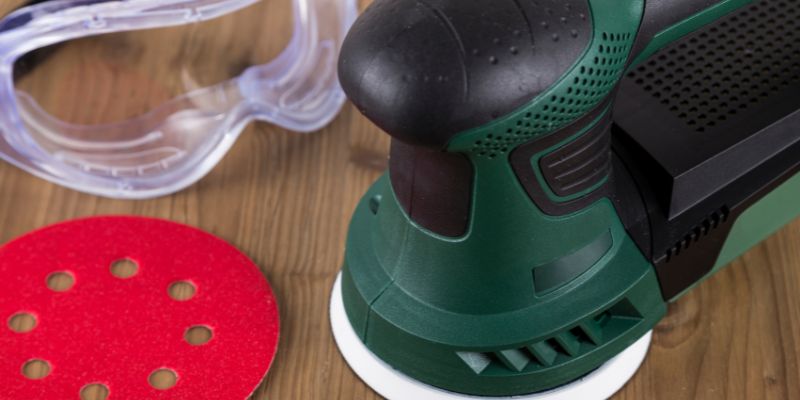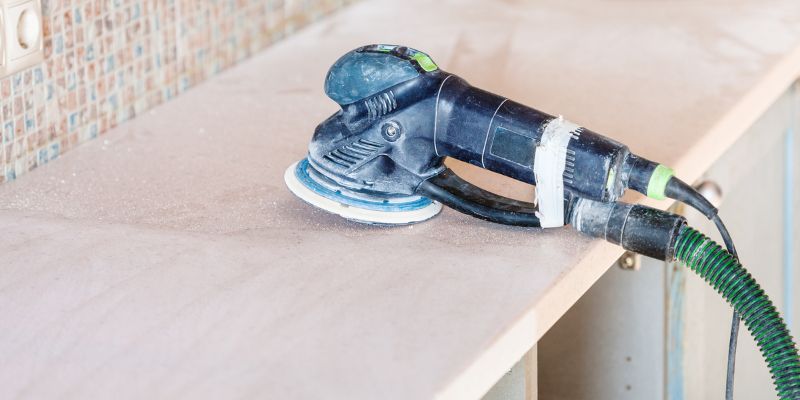When choosing between a sheet sander and an orbital sander, consider the type of sanding job you need to tackle. Sheet sanders are great for flat surfaces and edge sanding, while orbital sanders are versatile and ideal for curved and intricate surfaces.
Both sanders have their advantages and choosing the right one will depend on your specific project requirements. Sheet sanders feature a square pad and move in a straight-line motion, providing a fine finish for flat surfaces. On the other hand, orbital sanders have a round pad that moves in a circular motion, making them suitable for multiple types of sanding tasks, including removing paint and smoothing edges.
In this guide, we’ll compare sheet sanders and orbital sanders in terms of power, performance, and applications to help you make an informed decision for your next sanding project.
Understanding Sheet Sanders And Orbital Sanders
Differentiating Between Sheet Sanders And Orbital Sanders
When it comes to choosing the right power tool for smoothing out surfaces, it’s essential to understand the differences between sheet sanders and orbital sanders. Both these tools are designed to sand various materials, but they have distinct characteristics and purposes that make them suitable for different applications.
How They Work And Their Primary Functions
Sheet sanders, also known as finishing sanders, are best for providing a fine finish on surfaces. They utilize a square or rectangular sandpaper sheet that vibrates in a back-and-forth motion, allowing for precise sanding in tight spaces and corners. On the other hand, orbital sanders perform random orbital sanding motions to prevent swirl marks, making them suitable for removing material quickly and efficiently while still achieving a smooth finish.
By highlighting the distinct features and the primary functions of both sheet sanders and orbital sanders, you can make an informed choice based on the specific needs of your project. Whether you need intricate sanding in corners and tight spaces or efficient material removal with a smooth finish, understanding the differences between these two sanders will help you select the right tool for the job.
Factors Affecting Smoothness Of Finish
When it comes to achieving a smooth finish on your woodworking projects, understanding the factors that impact the final result is crucial. Two key elements that influence smoothness are the sanding patterns and techniques, grit size and sandpaper selection, and power and speed variations in sanders.
Sanding Patterns And Techniques
The choice of sanding pattern and technique plays a significant role in determining the smoothness of the finish. Circular or straight-line sanding patterns can influence the final appearance of the wood. Circular patterns are excellent for removing material quickly, while straight-line patterns provide a uniform surface. The sanding technique, including the pressure applied and the angle of the sander, also affects the smoothness.
Grit Size And Sandpaper Selection
Grit size and sandpaper selection are critical elements in achieving a smooth finish. Fine grits (higher numbers) produce smoother surfaces, while coarser grits (lower numbers) are suitable for material removal. Selecting the appropriate sandpaper for the job, whether it be abrasive discs, sheets, or belts, is vital for achieving the desired smoothness. Consult grit size charts to determine the best fit for your project.
Power And Speed Variations In Sanders
The power and speed variations in sanders directly impact the smoothness of the finish. More powerful sanders can remove material quicker, while variable speed controls allow for precision and finesse. Speed variations provide the flexibility to work on different materials with varying hardness, ensuring a smooth finish on hardwoods, softwoods, and composite materials.

Comparative Analysis Of Sanding Results
When it comes to achieving a smooth and flawless surface finish, the choice between a sheet sander and an orbital sander can significantly impact the overall outcome of your sanding project. Understanding the differences in the sanding results produced by each type of sander is crucial for selecting the most suitable tool for your specific woodworking or DIY needs. In this comparative analysis of sanding results, we will evaluate the finish quality achieved by sheet sanders and assess the finish quality achieved by orbital sanders to help you make an informed decision.
Evaluation Of Finish Quality Achieved By Sheet Sanders
Sheet sanders, also known as finishing sanders, are renowned for their ability to deliver a fine and uniform finish on flat surfaces. The square or rectangular sanding pad of a sheet sander enables it to reach corners and edges with ease, resulting in a consistent and smooth surface. The orbital motion of the sanding pad reduces the risk of swirl marks, making sheet sanders ideal for achieving a professional-grade finish on furniture, cabinets, and other woodworking projects.
Assessment Of Finish Quality Achieved By Orbital Sanders
Orbital sanders, characterized by their circular sanding pattern, excel in producing a smooth and swirl-free finish on various surfaces. The random orbital motion of these sanders eliminates the likelihood of sanding marks and provides a high-quality finish, particularly on curved or contoured surfaces. Orbital sanders are favored for their versatility and effectiveness in achieving flawless results on both wood and metal surfaces, making them a popular choice for woodworking enthusiasts and professionals alike.
Pros And Cons Of Sheet Sanders For Smoother Finishes
When it comes to achieving smooth finishes on wood, sheet sanders are a popular choice for many DIY enthusiasts and professional woodworkers. This tool is designed specifically for sanding large, flat surfaces and is known for its efficiency in delivering a smooth and even finish. However, like any tool, sheet sanders also have their limitations and drawbacks. In this article, we will discuss the pros and cons of using sheet sanders for achieving smoother finishes, so you can make an informed decision for your next sanding project.
Advantages Of Using Sheet Sanders For Achieving Smooth Finishes
Sheet sanders offer a range of benefits that make them an attractive choice for achieving smooth finishes on wood surfaces. Some of the key advantages of using sheet sanders include:
- Efficient material removal: Sheet sanders are designed to remove material quickly and effectively, making it easier to achieve a smooth finish in a shorter amount of time.
- Uniform sanding pattern: With their rectangular sanding pads, sheet sanders create a consistent sanding pattern, resulting in an even and uniform finish across the entire surface.
- Versatility: Sheet sanders can be used with a variety of sandpaper grits, allowing for versatility in achieving different levels of smoothness on wood surfaces.
- Dust collection: Many sheet sanders come equipped with dust collection systems to minimize airborne dust, providing a cleaner and healthier working environment.
Limitations And Drawbacks Of Using Sheet Sanders
While sheet sanders offer several advantages, they also have limitations and drawbacks that should be taken into consideration. Some of the common limitations of using sheet sanders include:
- Limited maneuverability: Due to their large and flat sanding pads, sheet sanders may struggle to reach tight corners and other hard-to-reach areas on a wood surface.
- Risk of over-sanding: Sheet sanders can be aggressive, and if not used carefully, they may inadvertently over-sand certain areas, leading to uneven surfaces.
- No orbital motion: Unlike orbital sanders, sheet sanders lack the orbital motion that helps prevent swirl marks and produces a finer finish on the wood surface.
Pros And Cons Of Orbital Sanders For Smoother Finishes
The use of power sanders has revolutionized the process of smoothing and finishing woodwork. When it comes to achieving impeccably smooth finishes, the orbital sander stands out as a popular choice among DIY enthusiasts and professional woodworkers alike. This article delves into the pros and cons of orbital sanders for achieving smoother finishes, highlighting the advantages and limitations of utilizing this power tool.
Advantages Of Using Orbital Sanders For Achieving Smooth Finishes
- Low-profile design enables easy access to tight spaces for uniform sanding.
- Random orbital motion reduces visible sanding marks and swirls on the workpiece.
- Ability to attach various grit sandpaper for versatile smoothing options.
- Efficient dust collection systems minimize airborne particles, making for a cleaner work environment.
Limitations And Drawbacks Of Using Orbital Sanders
- Compared to sheet sanders, orbital sanders may have a slower material removal rate.
- The circular sanding pattern can lead to increased sandpaper wear and replacement frequency.
- Less aggressive sanding action may require longer sanding times for thicker materials.
- Some models may vibrate more, causing hand fatigue during prolonged use.

Frequently Asked Questions For Sheet Sander Vs Orbital
What Are The Main Differences Between A Sheet Sander And An Orbital Sander?
The main differences lie in the sanding pattern and use cases. A sheet sander moves in a back-and-forth motion, suited for flat surfaces, while an orbital sander moves in a circular motion, ideal for finishing work and accessing tight corners.
Which Projects Are Best Suited For A Sheet Sander?
Sheet sanders are perfect for smoothing flat surfaces, such as doors, tabletops, and cabinets. They are efficient in removing paint or varnish and creating a smooth finish on large, flat areas.
In What Situations Should I Choose An Orbital Sander Over A Sheet Sander?
Opt for an orbital sander when working on intricate details, curved surfaces, or finishing touches. Its random orbital motion produces a finer finish and is less likely to leave swirl marks, making it ideal for delicate surfaces.
Conclusion
Ultimately, choosing between a sheet sander and an orbital sander depends on your specific project needs. Both tools have unique advantages, and understanding their differences is crucial for achieving the desired finish. Consider the job requirements, material, and desired effect to make an informed decision.
Always prioritize safety and precision when using power tools.


